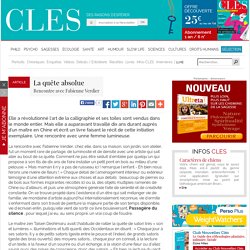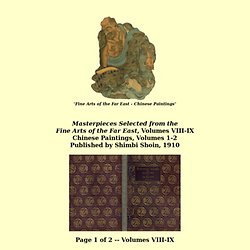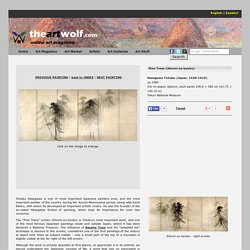

赵 少 昂 - Recherche Google. Beautiful Chinese animation. The Art of Ngan Siu-Mui. Les maîtres de la peinture chinoise. L'atelier de Fabienne Verdier, artiste peintre. La quête absolue. Le maître zen Taïsen Deshimaru avait l'habitude de railler la quête de satori très « son et lumières », illuminations et tutti quanti, des Occidentaux en disant : « Chaque jour à ses satoris.

Il y a de petits satoris (geste entre le pouce et l'index), de grands satoris (geste des bras ouverts), des moyens satoris... chaque jour on connaît, à la lecture d'un texte, à la faveur d'un sourire ou d'un échange, à la vision d'une fleur ou d'allez savoir quoi, des prises de conscience, donc des satoris. » Eh bien, la lecture du récit de Fabienne Verdier narrant son périple, en particulier les dix ans d'initiation et d'apprentissage en Chine auprès d'un et plusieurs maîtres des arts picturaux, a fait l'effet sur moi d'un très grand satori ! Voici donc quelques traces de notre visite chez l'ermite de la Sente aux fouines, de nos impressions et de notre conversation: l'œuvre humaine et la nature environnante semblaient, en ce beau jour de juin, ne faire qu'un. Page 16 Chinese Bird & Flower Paintings, China Birds Painting, Chinese Flowers Painting & Scrolls.
Page 1 of 2 Pages, Masterpieces Selected from the Fine Arts of the Far East, 5 Volume Set, Chinese Paintings, Volumes VIII-IX, Published by Shimbi Shoin, 1910. Tajima Shiichi (Editor, Volumes VIII & IX) Kubota, Kanroku (Editor, Volumes X - XII Omura Seigai (Original Text):Masterpieces Selected from the Fine Art of the Far East (Tôyô Bijutsu Taikwan), a 5 volume set, "Chinese Paintings, I-V," The Shimbi Shoin, Tokyo (13 Shinsakana-cho, Kyobashi-ku), 1909 (Volumes VIII & IX), 1918 (Second Edition, Volumes X-XII), folio (19 1/2 x 13 1/2 in - 50 x 34 cm), 5 volumes of art reproductions of Chinese art held in collections in Japan, 307 plates (57 are color woodblock prints and 250 are black and white collotypes), bound Japanese style, decorated cloth, purple silk threads, two edges gilt (top & bottom), 96 pages of text.

Volumes X-XII are "Deluxe Edition" and contain more color plates than the regular edition and many of the color woodblock plates are executed on silk. They are, however, not designated "Deluxe" on the title page and that is determined by the number of color woodblock plates and the fact that several are on silk. Hasegawa Tohaku - Pine Trees (Shorin-zu-byobu) Tohaku Hasegawa is one of most important Japanese painters ever, and the most important painter of the country during the Azuchi-Momoyama period, along with Kanō Eitoku, with whom he developed an important artistic rivalry.

He was the founder of the so-called Hasegawa School of painting, which kept its importance for over two centuries. The “Pine Trees” screen (Shorin-zu-byobu) is Tohaku’s most important work, and one of the most famous Japanese paintings inside and outside Japan, where it has been declared a National Treasure. The influence of Sesshu Toyo and his “splashed ink” technique is obvious in this screen, considered one of the first paintings of the history to depict only trees as subject matter - only a small part of the top of a mountain is slightly visible at the far right of the left screen. G. Fernández - theartwolf.com. Lssdfx.